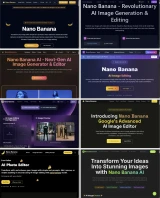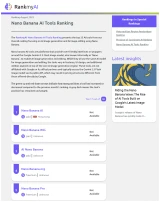Riding the Nano Banana Wave: The Rise of AI Tools Built on Google’s Latest Image Model
Written by Jesse Weltevreden
Google’s release of Nano Banana has quickly made it one of the most popular AI models for image generation and editing. This article explores its rapid adoption, the technical advances behind it, and the wave of independent wrappers built around it. We also introduce the Nano Banana AI Tools Ranking, highlighting which wrappers gain the most traction.
On August 26, 2025, Google released Gemini 2.5 Flash Image, widely known as Nano Banana. The model combines image generation and editing with subject consistency, multi image fusion and advanced semantic awareness. It is available through the Google Gemini app, Google AI Studio, the Google Gemini API, and Vertex AI for enterprise users.
Adoption and Popularity
Since its launch Nano Banana has seen rapid adoption worldwide. Google reports that the model helped bring over 10 million new users to the Google Gemini app within weeks, with more than 200 million image edits already processed.
MarketWatch noted that this surge pushed Google Gemini to the top of app store rankings, calling it a “Nano Banana frenzy”.
On the benchmarking platform LLM Arena, Nano Banana quickly became the most upvoted model for both image generation and image editing, receiving more than five million community votes in its first two weeks online.
Together these numbers show how Nano Banana moved almost overnight from a technical release to one of the most widely used and discussed AI models worldwide.
Why Nano Banana Stands Out
Nano Banana introduces several technical advances that distinguish it from earlier image models. Google highlights three core capabilities. The model can merge multiple input images into one coherent output. It maintains the identity of people, pets or objects across edits. And it enables detailed changes through natural language instructions. This makes it possible to blend photos, restyle images or replace backgrounds while retaining a consistent subject.
Real-world testing also shows notable subject consistency. In scenarios reviewed by Fello AI, the model preserved the look of people and objects across several edits even when backgrounds or styles were changed. Reviewers did observe some limits. Fine details can be lost and compositions may shift, but overall the performance was seen as stronger than most current image models.
Another review from VideoProc highlighted that Nano Banana produces images at a native 1K resolution. This works well for casual use and online publishing, but professional users may want to apply additional tools for higher-resolution outputs.
Taken together these reviews seem to confirm that Nano Banana’s strengths lie in accurate prompt following, consistent editing and subject preservation, although limitations such as detail loss and resolution constraints are also noted.

The Emergence of Nano Banana Wrappers

The popularity of Nano Banana has triggered a wave of independent projects that build services around the model. RankmyAI has identified more than 150 websites that use the official API to offer Nano Banana capabilities via consumer-facing interfaces.
Almost all of them present themselves as “Nano Banana” or close variations of the name, from Nano Banana AI to Nano Banana Pro. This can create the impression of official affiliation, but in reality these are all independent projects.
Many wrappers openly state that they use Google’s Nano Banana model, but most of them do not disclose who operates the website or where it is based. Background information collected by RankmyAI suggests that a large share originates from Asia, in particular China, as well as the United States. This lack of disclosure raises questions about privacy, security and long-term reliability.
Most wrappers are not free. They typically work with paid or freemium subscriptions, and the costs can be higher than using Nano Banana through Google’s official channels.
Pros, Cons and Risks
Wrappers can be convenient. They make Nano Banana more accessible through simple user interfaces, ready-made templates, local payment options, or availability in regions where official Google services may be limited.
But there are also drawbacks. Many wrappers charge higher fees than official channels. Privacy guarantees are often unclear. Reliability can be an issue as projects may disappear or change terms without warning. In many cases wrappers offer little more than branding and convenience rather than meaningful innovation.
Official Access to Nano Banana
For users who want predictability and security there are official ways to use Nano Banana. It is directly accessible in the Google Gemini mobile app, via Google AI Studio for developers (and also via Fal.ai and OpenRouter), through the Gemini API for custom integrations, and on Vertex AI for enterprise-scale use. These channels have transparent pricing, clear privacy policies and official support.
RankmyAI’s Response
To track this growing phenomenon RankmyAI has launched the Nano Banana AI Tools Ranking. The ranking is updated monthly and is based on traffic, reviews and investment. It shows which Nano Banana wrappers are gaining the most traction and which are losing momentum. As such it is the most extensive list of Nano Banana AI tools available today.
At the time of writing this blog we have just published the new monthly ranking which is based on data from August 2025. Since most wrappers have only launched recently many still lack the traffic data required to appear in our rankings. In the September edition, which will be published in mid October, we expect more Nano Banana AI tools to be included.
Although the ranking itself does not measure transparency, RankmyAI collects background information on each tool. This additional data often reveals limited disclosure about who operates the sites or how they handle data. Together the ranking and background research provide a clearer picture of how this new ecosystem is evolving.

Conclusion
The rise of Nano Banana wrappers shows how quickly a successful AI model can spark dozens of commercial spin-offs. Within weeks more than eighty five independent websites started offering access to the model under the Nano Banana name. Some provide a convenient entry point for casual users, but most add little beyond a branded interface and a payment system.
For users the key issue is whether these wrappers offer real advantages over official channels. The official Gemini app, Google AI Studio, the Gemini API and Vertex AI provide clear pricing, documented privacy policies and stable access. Wrappers compete mainly on branding, ease of use and local payment options. Unless they manage to build lasting trust and add meaningful features, many of these projects will struggle to survive once the initial hype fades.
By publishing the Nano Banana AI Tools Ranking RankmyAI gives insight into which wrappers are attracting traffic, receiving positive reviews and drawing investment. This makes visible which projects are gaining real market traction and which are already in decline. In doing so the ranking helps users and researchers cut through the noise and focus on the tools that truly shape how Nano Banana is being adopted worldwide.
Other articles
-

Latin America’s AI Adoption in Focus: RankmyAI’s Data in the ILIA 2025 Report
-

Picture-Perfect Profiles: A Smart Buyer’s Guide to AI Headshot Generators
-

AI 3D Modeling and Design Tools: From Prompt to Production-Ready Assets
-

Smarter Web Scraping: How AI Tools Turn the Web Into Structured, Usable Data


